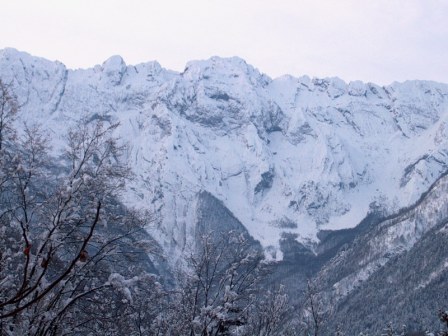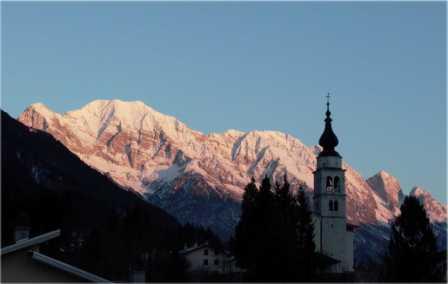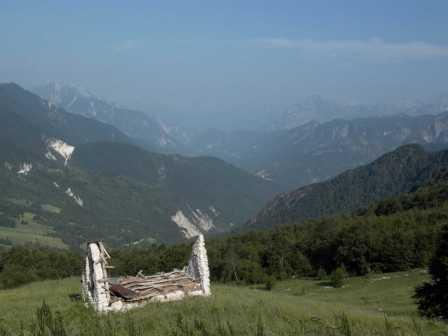Introduction to the website
Resia is a small alpine valley located in the north of Musi mountain range, embedded in the Julian Alps and pre-Alps, with a difficult and somehow discouraging access from the Fella Valley. The settlement of early dwellers can be traced back to the 6th century A.D.
 Several historians affirm that Slavic peoples movements started with a slow infiltration before the
beginning of Christian Era and had been unperceived for a long time by the Romans, who were intent on
facing Germanic peoples. The earliest sure information about the Slavs dates back to Procopius of Caesarea
and Jordanes who, in 550 A.D., attest to settlements in Carinthia (Austria), Slovakia and Bohemia. According
to writings of Paul the deacon, after a period of mutual aid, these tribes in Friuli region (North–east of
Italy) were locked in several battle against the Lombards and, after the battle of Lavariano, reached a
compromise, the so-called “Egg Pact”, which relegated Slavic populations forever to the eastern mountains
of Friuli region. Just in that period a few Slavic tribes strengthened their penetration of Resian territory
quite possibly in order to avoid massacres and reprisals by the winners. Documents, dated back 1084 A.D.
found in Moggio abbey, certify the presence of populations in the Upper Resia and in the Lower Resia. It is
possible, then, to affirm that from that date Resia followed the economical and political vicissitudes of
the locally close Friuli. During the whole Feudal Era up to the Napoleonic reign, the valley was
administratively divided into four municipalities, two of them, Osajanë and Solbyza, in the Upper Resia and
the other two, Bilä and Njyuä, in the Lower Resia.
Several historians affirm that Slavic peoples movements started with a slow infiltration before the
beginning of Christian Era and had been unperceived for a long time by the Romans, who were intent on
facing Germanic peoples. The earliest sure information about the Slavs dates back to Procopius of Caesarea
and Jordanes who, in 550 A.D., attest to settlements in Carinthia (Austria), Slovakia and Bohemia. According
to writings of Paul the deacon, after a period of mutual aid, these tribes in Friuli region (North–east of
Italy) were locked in several battle against the Lombards and, after the battle of Lavariano, reached a
compromise, the so-called “Egg Pact”, which relegated Slavic populations forever to the eastern mountains
of Friuli region. Just in that period a few Slavic tribes strengthened their penetration of Resian territory
quite possibly in order to avoid massacres and reprisals by the winners. Documents, dated back 1084 A.D.
found in Moggio abbey, certify the presence of populations in the Upper Resia and in the Lower Resia. It is
possible, then, to affirm that from that date Resia followed the economical and political vicissitudes of
the locally close Friuli. During the whole Feudal Era up to the Napoleonic reign, the valley was
administratively divided into four municipalities, two of them, Osajanë and Solbyza, in the Upper Resia and
the other two, Bilä and Njyuä, in the Lower Resia.
 The essentially mountainous territory only allowed activities connected to the exploitation of natural
resources. The only route which easily linked Resia to the external world was traced by the the Bila
Uödä River (White Water River), left affluent of Fella River, and by the winding path next to it.
The essentially mountainous territory only allowed activities connected to the exploitation of natural
resources. The only route which easily linked Resia to the external world was traced by the the Bila
Uödä River (White Water River), left affluent of Fella River, and by the winding path next to it.
Through that street, important for the fluctuation of the trunks, the Resians make contact with Friulian populations. The populations of the lower or western Resia started to deal with Friulian populations, while those coming from the oriental upper part moved over the mountains, founding Coritis and Uccea, and beyond the Isonzo River they entered in contact with the Slavs of Carniola (Carinthian Slovenes).
 Resia, therefore, functioned as a buffer state or a frank zone between the Slavic, German and
Friulian-Venetian worlds. We have already seen that up to 1805 Resia was divided in four municipalities.
In "Lypäväz", village of Prato, in the course of time it has been developed a language that, receiving
influences from the four main varieties of Resian, created a practical synthesis.
Resia, therefore, functioned as a buffer state or a frank zone between the Slavic, German and
Friulian-Venetian worlds. We have already seen that up to 1805 Resia was divided in four municipalities.
In "Lypäväz", village of Prato, in the course of time it has been developed a language that, receiving
influences from the four main varieties of Resian, created a practical synthesis.
The reader will allow me, at this point, a fantastic digression on the Russian origin of the Resians.
Because of the uniqueness of their own language, the Resians have always been marginalised, looked on with suspicion and treated with distrust by contiguous populations. Here is the flourish of the legend about the Russian origin of Resian people. Unconsciously, noticing the interest aroused among the first Russian researchers and realizing the affiliation of Resian language to the Slavic stock thanks to language similarities, valley-inhabitants strengthened the belief of belonging to a strong, mysterious nation but at the same time sufficiently distant from the borders of their homeland.
Resian people, however, oppressed by strong emigration, encircled by the superiority of Italian and English languages, is rapidly losing now what has jealously fostered for fifteen centuries. About twenty local scholars, the folkloristic group, the female choir and two cultural circles are desperately trying to revitalize the language through compositions, publications and lessons at school. In this re-born cultural background, the local virile choir "Monte Canin" has been playing its responsible part for thirty-five years.
All cultures in the valley nearby, in fact, are different. Resians (approximately three thousand native speakers) are trilingual: they can speak Resian, Friulian and Italian. About ten people can correctly speak Slovenian, five or six are also able to write it. Resiutta, the village where the principal road leads to, is inhabited by Friulian people; another road from Uccea leads to Slovenia, where people speaks Slovenian, and to Tanamea, Lusevera and Taipana where Po Nasen is spoken. Out of their sweet nest, Resians have to use a completely different language.
In 1999 N.482 law has been issued for the matters concerning the recognition of minorities, this law delegate the autonomous regional legislation of Friuli-Venezia Giulia for territory monitoring.
After national ratification about the presence in the Friuli-Venezia Giulia Region of Friulian, German, Slovene and Venetian-Julian populations, the legislator has promulgated the Law 23 February 2001 No. 38 – Regulations on the safeguard of Slovene minority of Friuli Venezia GIulia Region –. This law protects the Slovene minority of Trieste Karst, of Gorizia territory, of Natisone River valleys and of the Torre River territories, but at the same time it conforms and homogenizes Resia, Malborghetto/Valbruna and Tarvisio to the same minority. One fifth of city councilmen or 15% of the people registered in the electoral lists can decree the belonging to the minority.
The City Council of Resia has expressed its acceptation about the belonging to Slovene minority thanks to the vote of four councilmen of City Council minority and one of majority. Interventions shall also include contributions for cultural and recreational associations up to 50% of expenses that incur for the realization of cultural and tourist initiatives, their main purpose is to support manifestations of cultural associations in boundary municipalities where Slovene minority is present. It is evident that this law is considered dangerous by many Resians for the survival of their own cultural peculiarity because of the homologation of Resian to Slovenian. Maybe this is the reason which pushes many to preserve their identity through music and songs; Resians are aware of representing a cultural entity in quick dissolution that can hardly escape general homologation. The attachment to their own historical, political, social and cultural matrix has encouraged many people to write in Resian language, even by means of an own proper handwriting system or submitting their memories to whom is more familiar with pen and ink. Many Resians, also living outside their homeland, entrust their own emotions and feelings to the pages of the parish bulletin.